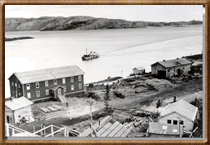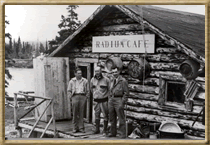|
Sahtú
and the Atomic Bomb, by Deborah Simmons
 In
1930, prospectors found pitch blend radium and uranium
at Great Bear Lake. At first, the main interest was
in the radium used for medical purposes. But when
the
lethal use of uranium was discovered, the Somba
K’e (Port Radium) mine was secretly transferred
to the Canadian government. The uranium ore from Great
Bear Lake was refined at Port Hope, Ontario, and from
there went directly to the Manhattan Project to make
an atomic bomb. After the destruction of Hiroshima and
Nagasaki, every ounce of Great Bear Lake uranium ore
was sent to the United States for the construction of
more bombs. An estimated 1.7 million tonnes of radioactive
tailings were left behind at the mine site when the
mine closed down. In
1930, prospectors found pitch blend radium and uranium
at Great Bear Lake. At first, the main interest was
in the radium used for medical purposes. But when
the
lethal use of uranium was discovered, the Somba
K’e (Port Radium) mine was secretly transferred
to the Canadian government. The uranium ore from Great
Bear Lake was refined at Port Hope, Ontario, and from
there went directly to the Manhattan Project to make
an atomic bomb. After the destruction of Hiroshima and
Nagasaki, every ounce of Great Bear Lake uranium ore
was sent to the United States for the construction of
more bombs. An estimated 1.7 million tonnes of radioactive
tailings were left behind at the mine site when the
mine closed down.
Many
people from the community were employed by the mine
as ore carriers. The ore had to be transported in 100-pound
bags down the Great Bear River by barge, then portaged
by truck at the rapids, and loaded onto another boat.
At every stop, the bags had to be loaded and unloaded
on the backs of the ore carriers. And every time it
was handled, the powdery ore would leak from the bags.
George
Blondin lived in front of the mine for 15 years. The
family subsisted in large part on fish from a net set
right in front of the mine. He says, “I thought
it was gold, they were going to make rings or something.”
Since that time, cancer has claimed three of his brothers,
as well as his wife and four of his seven children.
He believes that his family is just one of the many
that were impacted by the mine.
In
an effort to make amends, a delegation of Dene people
attended the peace ceremonies at Hiroshima in 1998 on
the anniversary of the bombing there. The first ore
carriers of the uranium that went into the bomb met
with the first people on whom the atomic bomb was dropped.
As Bella Modeste put it, “We Dene people are a
good people … We hope that blame won’t be
put on us because we had no knowledge about all that
happened in the war.”
 The
Deline Uranium committee has been conducting research
on the social and environmental impacts of the mine.
Negotiations with the federal government for cleanup
of the Somba K’e mine site are taking place
concurrently with self-government negotiations. The
Deline Uranium committee has been conducting research
on the social and environmental impacts of the mine.
Negotiations with the federal government for cleanup
of the Somba K’e mine site are taking place
concurrently with self-government negotiations.
The
documentary film Village of Widows (1999) on which this
article is largely based may be obtained from Lindum
Films in Toronto, phone 461-2305.
|